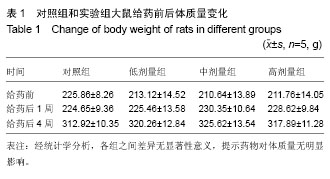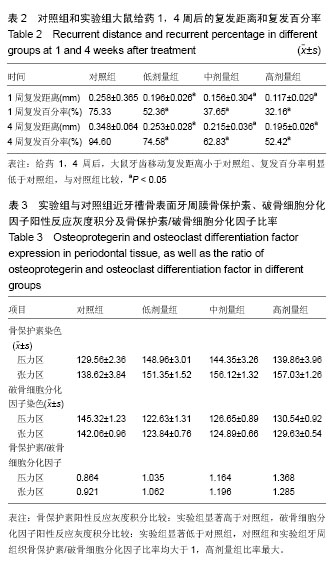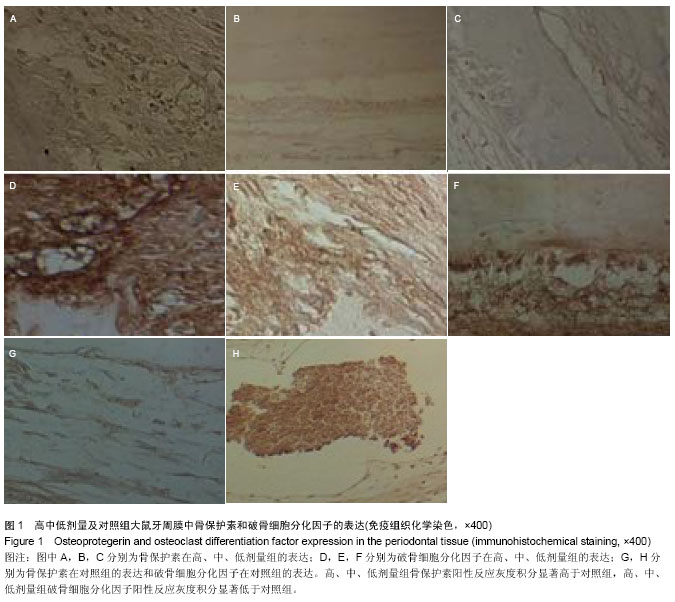| [1] Simonet WS,Lacey DL,Dunstan CR,et al. Osteoprotegerin: anovelseereted Protein Involved in the regulation of bone density.Cell.1997;89(2):309-319.[2] Franceca GoBi,Lorenz C, Hof Bauer,et al.The expression of osteoprotegerion and RANK ligand support of osteoclast for mation by stromal-osteoblast lingeage cells is developmentally regulated.Endocrinology. 2000;141(12): 4768-4776.[3] Yeung DK ,Leung SW, Xu YC, et al. Puerar in, anisof lavonoidderived fromRadix Puerariae, Potentiatesendonthelium in dependentr elaxat ionviatheeyelie AMPPathway In Poreinec oronary artery. Eur J Pharmaeol. 2006;552(1-3):105-111.[4] 黄生高,康祖铭,张建兴,等.旋转脉动磁场加速兔正畸牙移动的实验研究[J].中国现代医学杂志,2005,15(20):3085-3088[5] 张丁,傅民魁,傅嘉.丹参对离体破骨细胞的影响[J].口腔正畸学, 1995,2(2):63-64[6] 沈刚,陈荣敬,刘泓虎,等.复方灯盏花加速兔牙移动的运动学模型的建立与分析[J].口腔正畸学杂志,1998,5(1):31-33[7] 丁寅,陈华,徐如生.中药丹参加速正畸牙齿移动的研究[J].口腔医学,1995,15(3):120-121[8] 中华人民共和国卫生部药典委员会.中国药典[S].北京:人民卫生出版社1985:291-292[9] 中国医学科学院药物研究所编著.中草药现代研究(Ⅱ) [M].北京医科大学中国协和医科大学联合出版,1996:472. [10] 郑虎占,董泽宏,祭靖.中药现代研究与应用[M].2卷.北京:学苑出版社,1997,10.[11] 史炜镔,符诗聪,杜宁,等.丹参有效部位对骨折愈合过程中胶原基因表达的影响[J]中国中西医结合杂志,2000:20(4):269-271.[12] 林润台,王忠,刘立波,等.丹参促进下颌骨骨折愈合的超微结构研究[J].中华口医学杂志,1992:27(4):215-216.[13] Liu YR, Qu SX, Maitz MF, et al. The effect of the major components of Salvia Miltiorrhiza Bunge on bone marrow cells. J Ethnopharmacol. 2007 ;111(3):573-583. [14] 陈良娇,兰泽栋,陈建明. rhIL-1α与1,25-(OH)2D3联合作用对人牙周膜成纤维细胞表达RANKL和OPG的影响[J].口腔医学研究, 2012;28(4):316-320. [15] Ren Y, Maltha JC, Kuijpers-Jagtman AM. The rat as a model for orthodontic tooth movement a critical review and a proposed solution.Eur J Orthod.2004;26(5):483-490.[16] 黄艳,王旭霞,张君,等.正畸牙移动实验动物模型的建立[J].口腔医学,2007,27(2):64-65.[17] Hagashi H, Konoo T, Yamaquchi K, Intermittent 8-hour a ctivation in orthodontic molar movement.Am J Orthod Dentofacial Orthop.2004;125(3):302-309.[18] Ong CK, Walsh LJ, Harbrow D.et al.Orthodontic tooth movement in the prednisolone-treated rat.Angle Orthod. 2000;70(2):118-125.[19] Xu X, Zhang S, Zhang L, et al.The Neuro Proteetion of Puerarina gainst eerebralisehemia 15 associatedwiththe Preventionofa pop tosisinrats. Planta Med.2005;71(7):585-91.[20] Garat JA, Martin AE, Gordillo ME,et al.Effect of orthodontic forces on toot resorption in molars submitted to experimental periodomtitis.Acta Odontol Latinoam.2004;17(1-2):3-7.[21] 金作林,丁寅,李潇.雌激素治疗骨质疏松大鼠正畸牙移动的实验[J].中华口腔医学杂志,2001,35(1):55-57.[22] 陈丽萍.骨保护素的有关研究[J].牙体牙髓牙周病学杂志,2007, 17(6):361.[23] 刘宁,冯云霞,陈显久.不同正畸力对大鼠牙周组织压力侧 RANKL表达影响的研究 [J].中国实用口腔科杂志,2012,5(2): 104-108.[24] Liedert A, Wagner L, Seefried L, et al.Estrogen receptor and Wnt signaling interact to regulate early gene expression in response to mechanical strain in osteoblastic cells.Biochem Biophys.2010;394(3):755-759. [25] Orava S, Hulkko A, Koskinen S, et al. Stress fractures and bonehealth in track and field athletes. Sports Sci Med. 2000; 3(3):268-279. [26] Orava S, Hulkko A, Koskinen S, et al. Stress fractures in athletes military recruits. An overview.Orthopade. 1995;24(5): 457-466. [27] Lyritis GP, Georgoulas T, Zafeiris CP.Bone anabolic versus bone anticatabolic treatment of postme nopausal osteoporosis. Ann N Y Acad. 2010;1205:277-283.[28] 陈雁南,裴帆,李晓智,等.局部注射骨保护素与二磷酸盐对大鼠正畸牙移动的影响[J].解放军医学杂志,2011, 36(11):1200-1202, 1206.[29] 陈雁南,裴帆,李晓智,等.局部注射不同浓度骨保护素对大鼠正畸牙移动影响的研究[J].激光杂志,2011,5:89-90. [30] Bateman TA,Dunstan CR,Ferguson VL,et al.Osteoprotegerin mitigates tail suspension-induced osteopenia. Bone.2000; 26(5):443-449. [31] Bekker PJ, Holloway DL, Rasmussen AS,et al. A single-dose placebo-controlled study of AMG 162, a fully human monoclonal antibody to RANKL, in postmenopausal women. J Bone Miner Res.2004;19:1059-1066.[32] Manolagas SC,Jilka RL.Bone marrow,cytokines,and bone remodeling,Emerging insights into the pathophysiology of osteoponosis. N Engl J Med. 1995;332(5):305-311. [33] Quinn JM,Elliott J,Gilespie MT,et al.Endocrinology.1998;139(10):4424-4427.[34] 孔祥鹤,牛银波,李宇华,等.OPG/RANK/RANKL系统与骨质疏松研究最新进展[J].生命科学研究,2011,15(7):80-85.[35] Asuda H.Bone and bone related biot•heroical examinati(ms.Bone anti collagen related metabolites. Receptor actiator of NF-kappaB ligand(RANKL).Clin Calcium. 2006;16(6):964-970. [36] Shiotani A, Takami M, Itoh K, et al.Regulation of Osteoclast Differentiation and Function by Receptor Activator of NFkB Ligand and Osteoprotegerin.Anatomical Record.2002; 268: 137-146. [37] SahTlon P.Loss of chaotic trabecular structure in OPG-deficient juvenile Paget's disease patients indicates a chaogenic role for OPG in nonlinear pattern formation of trabecular bone.J Bone Miner Res. 2004;19(5):695-702. [38] 任嫒姝.应力刺激下成牙骨质细胞OPG/RANKL的表达及其信号转导通路的研究[D].成都:四川大学华西口腔医学院,2007. [39] Tang L, Lin Z, Li YM.Effects of different magnitudes of mechanical strain on Osteoblasts in vitro. Biochem Biophys Res Commun. 2006;344(1):122-128.[40] 贾少杰,贾晓静.绝经后女性骨质疏松与OPG、RANKL和ApoE的相关性研究[J].中国妇幼保健,2007,32(3):1001-1441. [41] 高延征,高坤,沈彬,等.去卵巢后大鼠骨组织中核因子κB受体活化因子配体和骨保护素表达的变化[J].中国组织工程研究与临床康复,2009,13(15):2877-2881. [42] 梁少俊,刘宏,杨力.绝经后骨质疏松与血清OPG及RANKL关系的研究[J].广东医学,2006,27(5):669-671. [43] 祝金香,张纲,武曦,等.RANKL/OPG 在高原低氧条件下兔牙周炎发病机制中的作用[J].第三军医大学学报,2012,(34)4: 320-323[44] Itonaga I,Fujikawa Y,Sabokbar A,et al.Rheumatoid arthritis synovial macrophage-osteoclast differentiation is osteoprotegerin ligand-dependent.J Pathol. 2000;192(1): 97-104. [45] Teng YT, Nguyen H,Kong YY, et al.Functional human T-cell immunity and osteoprotegerin ligand control alveolar bone destruction in periodontal infection. J Clin Invest.2000;106(6):59-67. [46] Mogi M, Otogoto J, Ota N, et al.Differential expression of RANKL and osteoprotegerin in gingival crevicular fluid of patients with periodontitis. J Dent Res. 2004;83(2):166-169. |



.jpg)